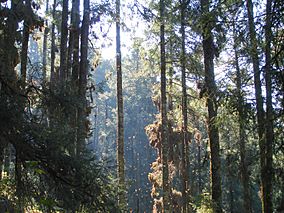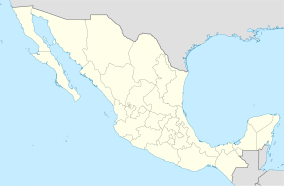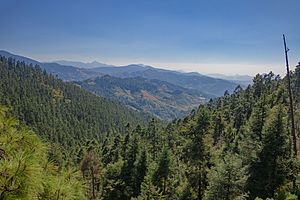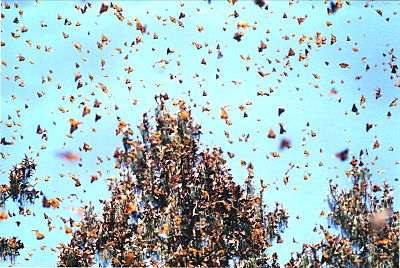Monarch Butterfly Biosphere Reserve facts for kids
Quick facts for kids Monarch Butterfly Biosphere Reserve |
|
|---|---|
| Reserva de Biosfera de la Mariposa Monarca | |

Entrance of Monarch Butterfly Biosphere Reserve
|
|
| Location | Michoacán-Mexico State border |
| Nearest city | Mexico City |
| Area | 56,000 hectares |
| Established | 1980 (as a wildlife refuge) |
| Type: | Natural |
| Criteria: | vii |
| Designated: | 2008 (32nd session) |
| Reference #: | 1290 |
| Region: | Latin America and the Caribbean |
The Monarch Butterfly Biosphere Reserve (Spanish: Reserva de Biosfera de la Mariposa Monarca) is a special World Heritage Site in Mexico. It protects the main places where millions of monarch butterflies spend the winter. These butterflies come from eastern North America.
The reserve is located in the Trans-Mexican Volcanic Belt pine-oak forests area. It sits on the border of Michoacán and State of Mexico, about 100 kilometers (62 miles) northwest of Mexico City. The butterflies only use a small part of the reserve's 56,000 hectares from October to March. The main goal of the reserve is to protect these butterflies and their homes.
Scientists found these special wintering areas in 1975. The Mexican government later made these areas a federal reserve in the 1980s and 2000s. The reserve became a Biosphere Reserve in 1980 and a World Heritage Site in 2008. Most of the land in the reserve is still rural. Protecting the butterflies can sometimes be tricky because it affects local farmers and landowners.
Contents
History of the Reserve
The area where the reserve is now was heavily logged in the 1800s. After the Mexican Revolution, Indigenous groups received land grants to help make up for this. The region has always been mostly rural, with communities of Otomi and Mazahua people living there. These communities traditionally used the mountain forests together, while lower hills were for family farms.
Protecting the Monarchs
In 1980, President José López Portillo first ordered protection for the monarch butterfly wintering areas. This happened after many years of research on how monarch butterflies migrate. In the late 1980s, the government gave the job of managing the reserve to a special department.
In 1986, a poet named Homero Aridjis helped convince President Miguel de la Madrid to give the wintering sites extra protection. A new rule was made that protected specific areas like Sierra Chincua and Cerro Pelón. These areas were set aside for the butterflies' migration, winter rest, and reproduction. The core zones, which are about 4,491 hectares (11,000 acres), had a "total ban on logging." Buffer zones, which are larger, allowed some economic activities if they followed environmental rules.
In 2000, the Monarch Butterfly Biosphere Reserve became much bigger, covering 56,259 hectares (217 square miles). In 2008, Homero Aridjis, who was Mexico's ambassador to UNESCO, helped the reserve become a World Heritage Site.
Challenges for the Butterflies
In 2014, a group of conservationists wrote to the leaders of Mexico, the U.S., and Canada. They said that the number of monarch butterflies had dropped a lot. In 1996, there were about 1.1 billion monarchs, but by 2013-2014, there were only 33 million.
Experts agreed that the main reason for this drop was the increase in genetically modified crops in the U.S. Corn Belt. Farmers sprayed a lot of herbicides on these fields, which destroyed milkweed plants. Milkweed is the only plant monarch caterpillars can eat. So, the butterflies were literally starving. Logging in Mexico's reserve also continued to be a problem.
The leaders of the three countries agreed to work together to save the monarch butterfly. In 2014, U.S. President Obama created a task force to help pollinators. One of its goals was to increase the monarch population to 225 million butterflies by 2020.
In 2016, many scientists and artists asked the leaders of Mexico, the U.S., and Canada to stop all logging in the reserve. In 2020, there were only nine monarch colonies in Mexico, with about 105 million butterflies.
An important person in butterfly conservation, Homero Gómez González, disappeared in January 2020. His disappearance caused fear in the community. He was a key figure in protecting the butterflies.
Ecosystem of the Reserve
Geography and Forest Cover
The reserve stretches across the mountains from eastern Michoacán to western Mexico State. This is about 100 kilometers northwest of Mexico City. In Michoacán, the reserve has very high peaks, some reaching 2,700 meters (8,858 feet) above sea level. The weather here is mild and a bit moist, with a rainy season in the summer. The average highest temperature is 22 °C (71 °F).
The area has many basalt rock formations, with cracks and cliffs. The soil lets water pass through easily, so there isn't much surface water like big rivers. Small ponds and streams can be found. The forests are made of pine and oyamel fir trees. These trees create special microclimates that protect the butterflies when it gets very cold or rainy in winter. Scientists are worried that the oyamel fir forests might shrink or disappear by the end of this century because of climate change.
The types of trees in the forest change with how high up you go:
- Holm oak trees grow up to 2900 meters (9,514 feet) above sea level.
- Holm oak and pine trees grow between 1500 and 3000 meters (4,921 and 9,842 feet) above sea level.
- Oyamel fir trees grow between 2400 and 3600 meters (7,874 and 11,811 feet) above sea level.
Below 2400 meters (7,874 feet), there are small areas with junipers, cedars, and meadows. Some parts of the reserve have been changed by farming and human settlements.
Fauna (Animals)
The reserve is home to many different animals, from those that like warm weather to those that like cold. Some animals found here are white-tailed deer (Odocoileus virginianus), coyotes (Canis latrans), long-tailed weasels (Neogale frenata), and grey foxes (Urocyon cinereoargenteus). You can also see rabbits (Sylvilagus spp.), ravens (Corvus corax), turkey vultures (Cathartes aura), and great horned owls (Bubo virginianus). Many types of hummingbirds, reptiles, and amphibians also live here.
There are fourteen main butterfly colonies in these rugged mountains. More than half of the monarch butterflies from the eastern U.S. and Canada spend their winter here. It's thought that up to a billion butterflies can be here in a single year. These colonies are very dense, with six to sixty million butterflies in just one hectare (about 2.5 acres).
The reserve areas are in several towns in Michoacán and the State of Mexico. Eight of the fourteen colonies are in the protected area. The actual butterfly colonies cover only 4.7 hectares, but the protected biosphere area is much larger, at 56,259 hectares. Five colonies are open for visitors: Sierra Chincua and El Rosario in Michoacán, and La Mesa, Piedra Herrada, and El Capulin in the State of Mexico. El Rosario is the biggest sanctuary in Michoacán, where butterflies cover about 1,500 trees.
The reserve has made improvements, especially at the El Rosario sanctuary. They have clear walking paths with security and stone steps in steep areas to prevent erosion. Horse paths were removed for the same reason. There are research facilities at Sierra Chincua and tourism facilities at Cerro El Companario.
Climate
The reserve has a Subtropical Highland climate, often classified as Cwb under the Köppen climate classification. This is characterized by mild, dry winters and warm, wet summers. The climate is heavily influenced by its high altitude (2,900 to 3,600 meters or 9,500 to 11,800 feet above sea level).
Seasonal Breakdown
The most important way to understand the reserve's climate is by dividing the year into two main seasons, which perfectly align with the monarchs' overwintering period.
1. The Dry, Cool Winter
(Overwintering Season: November - March)
This is the season when the monarch butterflies are present. The climate conditions are precisely why they choose this location.
Days are sunny and mild, with highs ranging from 15°C to 22°C (59°F to 72°F). Nights and early mornings are cold, often dropping to 0°C to 5°C (32°F to 41°F). Frost is not uncommon.
- Precipitation: This is the dry season. Rainfall is rare.
- Weather Conditions: The days are sunny. The abundant sunshine is crucial. It allows the butterflies to bask and warm their flight muscles enough to move, drink water, and fly short distances. The nights are cold. The cold temperatures put the monarchs into a state of semi-hibernation (torpor), slowing their metabolism and conserving their energy reserves, which they need to survive the winter.
This delicate balance is essential. If it were any warmer, the butterflies would use up their fat reserves too quickly. If it were any colder or wetter, they would freeze to death. The Oyamel fir forests provide a blanket effect, moderating the temperature and protecting them from freezing rains and extreme cold.
2. The Warm, Wet Summer
(Rainy Season: May - October)
The monarchs are in their breeding grounds in the north (the U.S. and Canada) during this time.
Days are warm, with highs around 20°C to 25°C (68°F to 77°F). Nights remain cool.
- Precipitation:This is the rainy season. It receives the vast majority of its annual rainfall, often in the form of afternoon showers and thunderstorms. Humidity is high.
- Weather Conditions: Lush, green, and often cloudy or rainy in the afternoons.
Conservation Efforts
Monarch Butterfly Migration and Protection
Millions of monarch butterflies fly south into Mexico from Texas. They follow the Sierra Madre Oriental mountains to reach the reserve. The butterflies gather together, covering pine and oyamel trees. Sometimes, the trees look orange, and branches bend from the weight of so many butterflies. In spring, these butterflies fly back north across America, some even reaching Eastern Canada. During this long journey, four generations of monarch butterflies are born and die. Climate change can affect their migration patterns. When it gets warmer, the butterflies start to fly north. When they are gathered closely, they stay warm. If the sun warms them, they take flight, and the sound of their wings can be like light rain. The reserve can get very cold, which can be dangerous for the butterflies.
At first, conservation efforts focused on protecting the butterflies themselves. Now, the main goal is to protect their habitat. The survival of monarch butterflies depends on many different habitats across North America. We still need to learn more about the butterflies, including the full size of their wintering areas and the local environment. This will help us know how large the reserve needs to be to truly protect them.
Since conservation efforts began, there has been good progress. While some facilities are still needed, improvements have been made in managing trash and controlling who enters the protected areas. The World Wildlife Fund has helped bring together biologists and ecologists from different countries to improve the reserve's design. A system is now in place to regularly check the forests to make sure they are healthy and to stop illegal logging and forest fires.
During the winter of 2008–2009, there were plans to tag as many wintering butterflies as possible with very light stickers. This helps scientists find out the exact migration route as the butterflies fly back north in the spring. The number of butterfly colonies changes each year, usually between eight and twelve.
Land Use and Challenges
Most of the reserve is home to rural farming communities of Otomi and Mazahua peoples. Many protected areas are not owned by the government directly. The reserve is also split by a state line, which makes conservation efforts more complex. The biggest threats to the butterfly habitat inside the reserve are deforestation, illegal logging, uncontrolled tourism, forest fires, and a lack of teamwork among different authorities. Most of these problems come from the nearby human settlements, which put pressure on the natural resources.
The needs of local residents, landowners, and farmers are considered in conservation plans, but sometimes their interests don't match. Even though the Mexican government made the area a biosphere reserve, most of the land is owned by 38 ejidos (community-owned lands), seven Indigenous communities, and 16 private owners. Many communities in this region are poor, with limited access to basic services.
In the past, mining provided many jobs, but those mines are now empty. These communities also have a tradition of using forest areas, mostly for wood to make furniture and crafts. High unemployment, especially among young people, leads many to move to other parts of Mexico or to the United States and Canada. Today, people in the reserve area farm for their own food, raise animals, and sell crafts and food to tourists. Communities that agree to help with conservation can get paid through a program called Payment for Ecosystem Services (PES). This program pays communities for keeping their forests healthy and untouched by logging.
Tourism in the Reserve
In the early 2000s, rules were changed to allow seasonal tourism in parts of the reserve. Five of the eight butterfly colonies are in Michoacán, but only two are open to the public: Sierra Chincua in Angangueo and El Rosario in Ocampo. Both welcome visitors from November to March, and local people offer guided tours. In the State of Mexico, La Mesa and El Capulin are open to the public. Thousands of Mexican and international tourists visit the reserves, mainly from the United States, Canada, Europe, and Japan. El Rosario is the most famous and visited butterfly colony. Some conservationists worry about how many tourists might affect the environment.
In February, Angangueo celebrates its Festival de la Mariposa Monarca (Monarch Butterfly Festival). This festival started in 1992 to raise awareness about the butterflies, encourage ecotourism, and promote local culture and arts. The festival includes food, music, dance, and art exhibitions. Many nearby communities also take part. In 2010, the festival featured a symphony orchestra and art exhibitions.
In January 2016, Google honored the 41st anniversary of the discovery of the "Mountain of the Butterflies" with a special Google doodle.
Challenges and Future
Conservation efforts often involve rules about how land can be used. However, the communities living in the reserve have not always been directly involved in making these rules. Some groups have worked with communities to create ways to encourage forest conservation and benefit from butterfly tourism. But success has been mixed. Some communities want to use more land for farming and are pushing back against the restrictions.
One expert, Dr. Gonzalez-Duarte, points out that big international organizations have sometimes made decisions about Indigenous lands without fully understanding local needs. She explains that when private and public groups got involved, it changed how the land was used. This led to some areas being controlled by the state or private groups instead of being shared by the community. This can sometimes create problems and even lead to unsafe situations in the forest.
The presence of the UNESCO program and other large systems has changed relationships between people and nature. This has sometimes made it harder for local people to thrive. Dr. Gonzalez-Duarte suggests that using ideas from traditional ecological knowledge, which focuses on living in harmony with nature, could help improve conservation efforts for everyone involved.
See also
 In Spanish: Reserva de la Biosfera de la Mariposa Monarca para niños
In Spanish: Reserva de la Biosfera de la Mariposa Monarca para niños
- Animal migration
- Climate change and ecosystems
- Lepidoptera migration
- List of butterflies of North America
- Monarch (butterfly)
- Monarch butterfly migration






